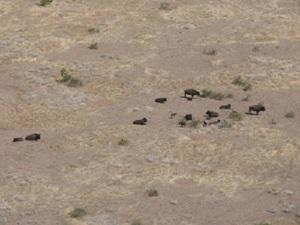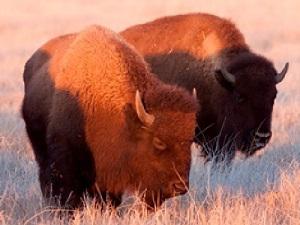Véronica Solis Gracia
The main objective of this project is to determine possible sites for bison reintroduction in north-western Mexico, in order to achieve –in the long term- grassland restoration. We seek recovery of ecological processes and interactions linked with bison, while aiming to recover the respect and positive interaction between humans and bison.

Bison and calves aerial view.
Bison (Bison bison) is a keystone and flagship species that evolved in North American prairies, closely related with humans. At the end of the 19th century bison population was decimated from 10 to 60 million to about a thousand individuals. After recovery efforts, they now number more than half a million, but most of them are managed as cattle, which still presents the challenge of recovering bison’s prior ecological role.

Two of the twenty three transloctaed bison. © Rurik List.
The new vision for bison recovery contemplates a large-scale recovery in time and space that can only be achieved through local projects along bison’s historic distribution range. The recovery of bison in Mexico implies the recuperation of a keystone species and the largest mammal in the continent, which is practically absent within Mexico. Currently, there is one free-ranging herd that roams along the border of Hidalgo, New Mexico, USA and Janos, Chihuahua, Mexico. Data taken from the use of habitat of this herd will help detect other areas suitable for bison in this region.
The project’s aim is to set the first steps necessary to reintroduce bison in northern Mexico. It will detect sites that are suitable for reintroduction from an ecological and socio-cultural point of view, and will set the first approach with communities to learn their perspective on this issue. This will be done through analysis with Geographic Information Systems (GIS) and predictive models using data from aerial surveys from the Janos-Hidalgo herd. We will also conduct interviews among the people of the communities to gather information about sites formerly used by bison in the region, to get acquainted with the people, and to learn their perspective regarding the presence of bison in the area and its potential reintroduction. This will help develop the best strategies for the reintroduction process. Bison reintroduction will be accompanied by the recovery of interactions with its environment and humans. Bison is also listed as one of the 35 priority species for the National Commission of Protected Areas in Mexico for recovery during this administration.
The results obtained from this project will transcend into an Action Plan for the Conservation of Species, which will enhance the conservation of bison, their ecological role, and the grasslands they inhabit, whilst promoting better livelihoods.